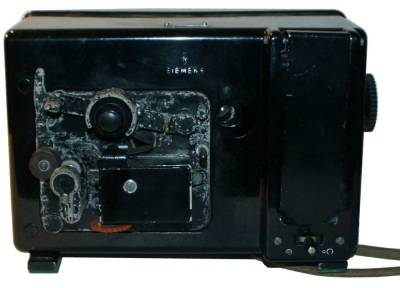Inhaltsverzeichnis
Hellschreiber 41
Hellschreiber 41 with the Hell printer T. empf. 14; manufactured by Siemens & Halske, Berlin.
The Hellschreiber or the teleprinter according to R. Hell was developed by Rudolf Hell in 1929; the Hell-Schreiber systems sold by Siemens were accepted with enthousiasm, especially in press and commercial radio.
The text messages in the form of a punched paper tape are converted by the Hell generator into a grid of 7 x 7 pixels and this signal is fed to the transmitter as a pulse sequence. In the radio receiver, the audio pulses are amplified and fed to a printer, which uses a writing spindle to print the message in duplicate on a paper tape.
Technical data
- Principle]]: Teleprinter
- Operation modes: Hell (quasi-facsimile system according to Dr Rudolf Hell)
Power supply
- Mains operation: 220 V AC mains
Dimensions
Accessories
System components
The Hell system consists of a „Hand punch“, into which the message is typed to create suitable punched paper tapes.

The various components are connected to the transmitter-side power connection box and can be switched on from a central power switch.

The punched tape reader reads the punched tape and generates the Hell signal.
An audio-frequency of 900 Hz from the Röhrensummer T. Sum. 5a (AF generator) is superimposed to the signal from the punched tape reader, the Hell signal is fed to the transmitter. Keying of the transmitter is done at the grid of the keying valve by on-off keying of the carrier wave.
On the side of the receiving station, all the components are also plugged into a wooden power distribution box and can be switched on together.

On the receiver side, the audio-frequency signal must be amplified (in the Amplifier T. Verst. 18a) and is fed to the Hell printer.

In the Hell Printer T. Empf. 14 a double screw is pulled by electromagnets to print the characters on the slowly moving paper strip.

If the speed is poorly synchronised, the two printouts of the message run at an angle, but the message itself remains legible. The synchronisation can be adjusted with the speed control until the two print strips run exactly parallel indicating optimum synchronisation.

Technical principle
Character transmission in a quasi-facsimile process with 7 x 7 pixels.
Tube assembly
- in the tube buzzer T. Sum. 5a: one EDD11, one fuse 300 mA
Development
The sets developed by engineer Rudolph Hell were manufactured by Siemens & Halske, Berlin and sold for the civilian market.
Use
From the high power radio station G1.5K, the stations from serial number 15 onwards were equipped with the Hellschreiber 41, of which 13 systems were acquired. the system consists of two crates and the paper tape punch.
Technical documentation
Further information
- Siemens Hell Schreiber T.12b and T14 on the website of Frank Dörenberg





